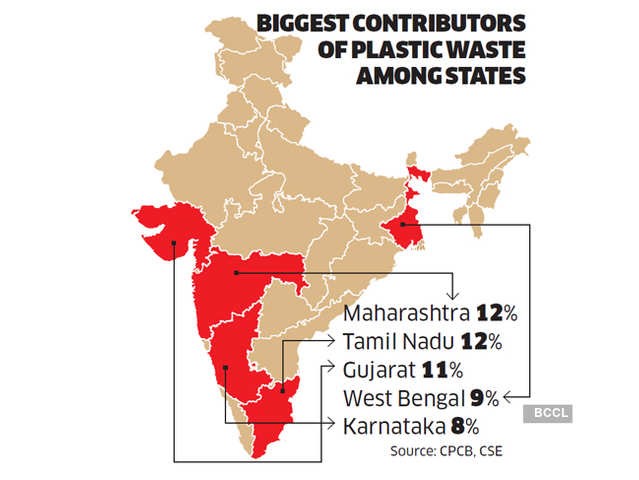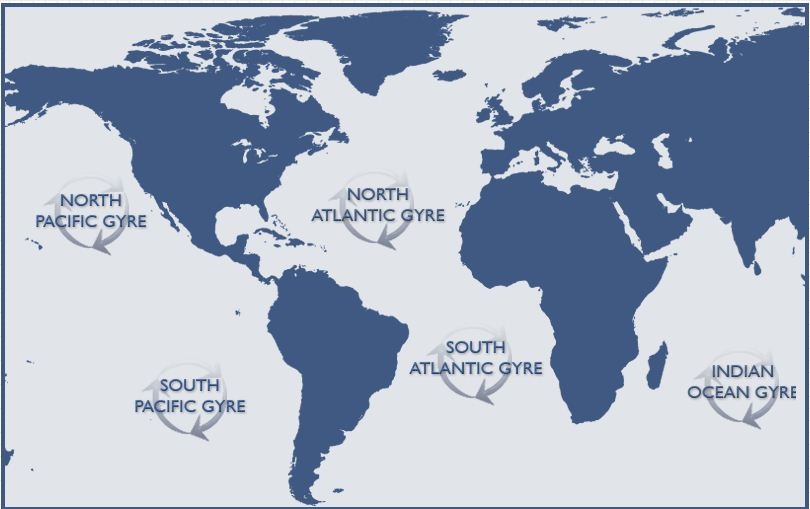Plastic Waste Management in India
2021 AUG 18
Mains >
Environment & Ecology > Pollution > Plastic pollution

IN NEWS:
- The Ministry of Environment, Forest and Climate Change has notified the Plastic Waste Management Amendment Rules, 2021, which prohibits several single use plastic items by 2022.
PLASTIC WASTE IN INDIA:
- According to FICCI, an Indian consumes 11 kg of plastic per year. But this figure is estimated to rise in the coming years.
- According to the Central Pollution Control Board (CPCB), as much as 3.3 million metric tonnes of plastic waste was generated in India in 2018-19, of which only about 60% is recycled.
- India’s contribution is around 3.1% of the global plastic waste generation.
- The total municipal solid waste generation is 55-65 million tonnes, of which plastic waste is approximately 5-6 percent.
THREATS FROM PLASTIC POLLUTION:
- Persistence in environment:
- Synthetic plastics are largely nonbiodegradable and tend to persist in natural environments. They eventually fill the land and water, affecting the fertility and quality of the ecosystem.
- Marine pollution:
- Every year, about 8 million tons of plastic waste escapes into the oceans from coastal nations. This floating plastic waste has accumulated in five subtropical gyres that cover 40 percent of the world’s oceans.
- The most noted among these is the Great Pacific Garbage Patch—a 600-sq km floating island of plastic waste in the North Pacific Ocean.

- Air pollution:
- Burning of plastics leads to environmental pollution due to the release of poisonous chemicals. The polluted air, when inhaled, affects the health and can cause respiratory problems.
- Generation of microplastics:
- Once dumped, the plastics break down into small particles called microplastics and spreads throughout the water cycle. They eventually enter the drinking water systems and gets accumulated in the body, affecting liver functioning and disrupting reproductive systems.
- Threat to organisms:
- Millions of animals are killed by plastics every year, from birds to fish to other marine organisms. Most of the deaths to animals are caused by entanglement in objects such as fishing gear, or through ingestion of plastics.
- New research shows that larval fish are eating nanofibers, raising questions on the threats posed by plastics on the food chain.
- Soil and water degradation:
- When plastic is dumped in landfills, it interacts with soil and water to leach out hazardous chemicals. When these chemicals seep underground, they degrade the water quality.
- Also, plastics in landfills can form an impervious layer in the soil, which reduces the seepage of surface water into the ground. This can reduce the groundwater table and increase risks of water scarcity.
PLASTIC WASTE MANAGEMENT IN INDIA:
- Plastic Waste (Management and Handling) Rules, 2011:
- India’s first attempt at tackling the menace of plastic waste came in 2011 when the government notified the Plastic Waste (Management and Handling) Rules, 2011.
- It sought to disincentivise the use of poly bags by setting up a pricing mechanism for them and also to established rules for recycling by local authorities.
- Plastic Waste Management Rules, 2016:
- It replaced the 2011 Rules. It gave emphasis on a complete ban on plastics below 50 microns, phasing out use of multi-layered packaging and introduced Extended Producer Responsibility (EPR).
- Other efforts:
- In 2018, on World Environment Day, India asserted that it would eliminate all single-use plastic by 2022. Prime Minister Narendra Modi was conferred the “champions of the earth” award by the United Nations Environment Programme (UNEP) for this pledge.
- Waste management infrastructure in the States/UTs is being strengthened through the Swachh Bharat Mission.
- India Plastic Challenge – Hackathon 2021:
- The hackathon was organized for students of higher educational institutions and startups recognized under Startup India Initiative.
- To encourage innovation in development of alternatives to identified single use plastic items and digital solutions to plastic waste management.
- Two-month long Awareness Campaign of Single Use Plastic 2021 was organised for awareness generation towards elimination of single use plastics.
- India Plastics Pact: It is a collaborative initiative that aims to bring together businesses, governments and NGOs across the whole value chain to set time-bound commitments to reduce plastics from their value chains.
|
Extended Producer Responsibility (EPR):
EPR is a policy approach under which producers are given a significant responsibility – financial and/or physical – for the treatment or disposal of post-consumer products. It is the commitment made by a producer to facilitate a reverse collection mechanism and recycling of end of life, post-consumer waste.
|
PLASTIC WASTE MANAGEMENT AMENDMENT RULES, 2021:
- Complete ban on some single use plastics:
- The manufacture, sale and use of some single-use goods made with plastics, polystyrene, and expanded polystyrene are prohibited from July 1, 2022.
- This will cover items such as earbuds, plates, cups, glasses, cutlery, wrapping and packing films.
- Gradual phasing out:
- The permitted thickness of the plastic bags, currently 50 microns, will be increased to 75 microns from 30th September, 2021, and to 120 microns from the 31st December, 2022.
- The Central Pollution Control Board, along with state pollution bodies, will monitor the ban, identify violations, and impose penalties already prescribed under the Environmental Protection Act, 1986.
CHALLENGES IN PLASTIC WASTE MANAGEMENT:
- Volume of waste generated:
- With rapid urbanisation, rising population and increasing dependence on plastics, the amount of waste generated far exceeds the management capabilities. This leads to accumulation of plastics, which are eventually burned.
- Absence of segregation:
- Due to the absence of waste segregation at source into biodegradable and non-biodegradable, considerable amount of plastic waste is not recycled, leading to it being incinerated or dumped in landfills.
- Fewer alternatives:
- Ban on plastics have had limited success due to absence of alternatives. Eg: Bioplastic production in India is just 1% out of 300 million tonnes of conventional plastics produced annually.
- Informal waste management sector:
- Waste collection and processing in India is carried out largely by the informal sector. This makes it difficult to implement the waste management rules, ensure scientific disposal of wastes and address the welfare of workers.
- Lack of awareness:
- People lack proper awareness regarding the threats posed by plastics or the need of better waste disposal for their health and wellbeing.
- Weak enforcement:
- 22 States have, in the past, announced a ban on single-use plastic. But this has had little impact on the crisis because governments were half-hearted in their approach, fearing that a ban would be too disruptive for industry and the economy.
- Unempowered local government bodies:
- Due to lack of funds and technical expertise, local governments rely on burning plastic wastes or on municipal contracts, where companies are paid for haulage of mixed waste. This leads to rise in pollution, dumping and loss of potential revenue from wastes.
- Absence of community participation:
- Due to lack of incentivisation and awareness, participation from non-profits or community is limited. Also, most of the rules encourage centralized treatment such as waste to energy, which is still under-developed in the country.
- Unbalanced spending:
- Three-fourth of solid waste management budget is allotted to collection and transportation, which leaves very little for processing or resource recovery and disposal.
WAY FORWARD:
- Decentralise waste management:
- Civic bodies have to redraw long term vision in solid waste management and rework their strategies as per changing lifestyles. They should reinvent garbage management in cities so as to process waste and not landfill it.
- Segregation at source:
- The key to efficient waste management is to ensure proper segregation of waste at source and to ensure that the waste goes through different streams of recycling and resource recovery.
- Promote alternatives to plastics:
- Alternatives such as biodegradable plastics, geotextiles and waste-to-energy plants are crucial for solid waste management.
- Formalise the sector:
- Waste collection and processing should be developed into a formal, technology-reliant sector. Start-ups and PPP models need to be encouraged in the sector.
- Incentivise the business:
- Government should provide viability gap funding for waste processing infrastructure projects to make in financially viable.
- It may also look into incentivising people for proper waste segregation and using recycled products.
- Promote awareness:
- Managing plastic waste requires effective knowledge, not only among those who produce the plastic, but also among those who handle it.
- International cooperation:
- The international view is changing and support for a ‘Plastic Treaty’ is growing. India should take the lead role and push for an international agreement on regulating plastic and plastic wastes.
CASE STUDY: Rwanda’s ban on plastics:
- Since 2008, the African country banned the import, manufacture and distribution of plastic, with a few exceptions.
- Backed by strong political will by the government, Municipalities are responsible for enforcement of the ban.
- On the last Saturday of every month, from 8 to 11 am, people across the country gather to clean their neighbourhoods.
- Every school in Rwanda has an “environment club”, where trained teachers inculcate messages of cleanliness to students and through them to their parents.
- Violation of the ban or non-participation in community work can invite jail time or a fine.
- The ban has helped the country’s economy, as Rwanda has seen an increase in tourism due to its cleanliness.
PRACTICE QUESTION:
Q. Discuss the threats posed by plastic pollution. What measures have the government taken to address it?

